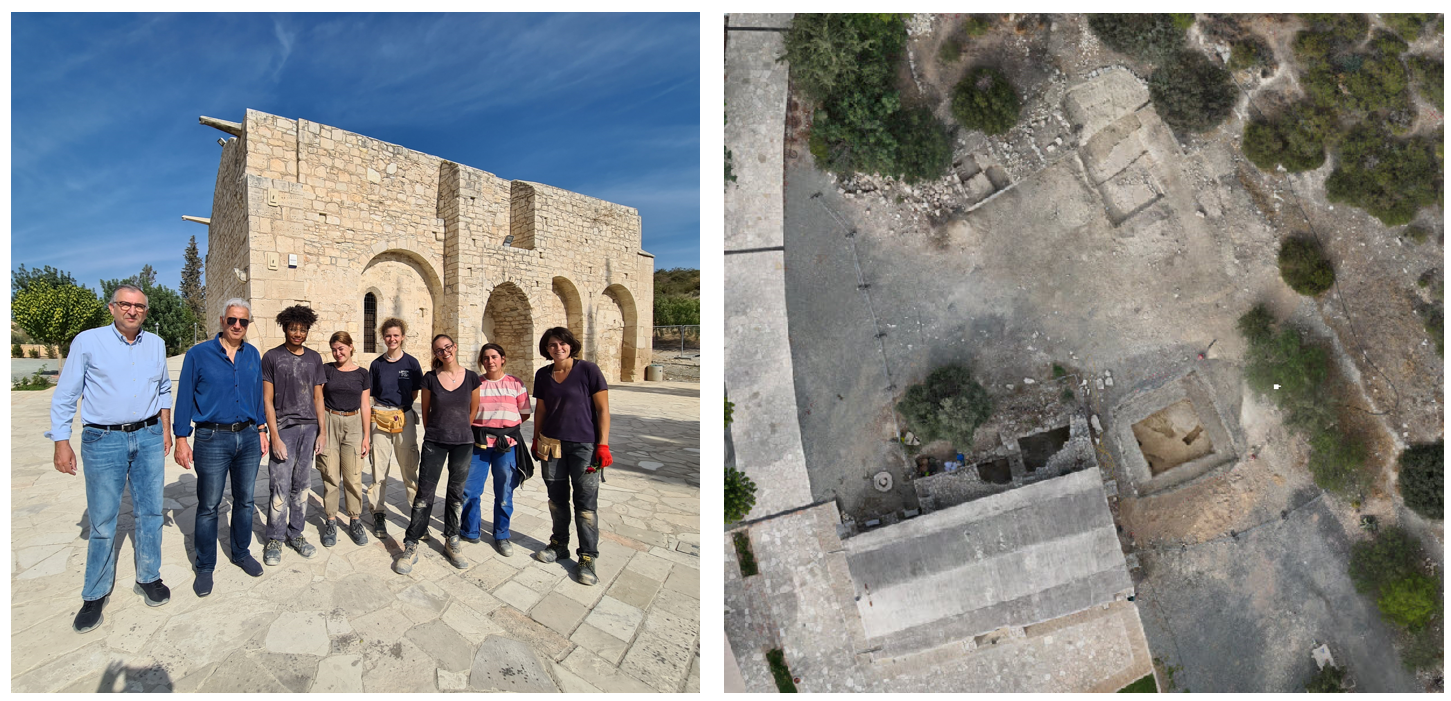The ERATOSTHENES Centre of Excellence of the Cyprus University of Technology, and the Aix-Marseille University (AMU) through the Laboratoire d’archéologie médiévale et moderne en Méditerranée (LA3M) and the Department of Antiquities, Deputy Ministry of Culture, announces the completion of the first excavation season of the “Panagia Karmiotissa” project. The excavation took place at the area surrounding the church of Panagia Karmiotissa under the direction of Dr. Andreas Nikolaides and Dr. Margot Hoffelt.
The project is the result of two years of close collaboration between the ERATOSTHENES Center of Excellence and the CNRS Laboratoire d’archéologie médiévale et moderne en Méditerranée (LA3M), https://la3m.cnrs.fr/ . The research team, which consists of Dr. Margot Hoffelt, Dr. Andreas Nicolaides, Dr. Kyriacos Themistocleous and Dr. Andreas Anayiotos and would like to thank the Cyprus Department of Antiquities and the Bishopric of Lemesos for their support, and especially the Panagia Evangelistria’s ecclesiastical committee of Kato Polemidia for their financial contribution and hospitality.
For several reasons, such as second hand sources, topography, toponymy, oral tradition, etc., the site was suspected to be established by the Carmelites in Cyprus during the 13th century. The existing church, according to architectural references, is estimated to have been built prior to the 14th century. However, it was therefore necessary to get to the underlying archaeological layers in order to investigate the stratigraphical potential of the area.
Three test pits were implemented: two in the northern terraces and one behind the church chevet. In the most eastern terrace pit, at least three occupation levels were observed. The ceramics collected on the intermediary level appear to date back to the 13th century, thereby confirming an occupation of the site at a time which corresponds to the arrival of the Carmelites in Cyprus. In the most western terrace pit, two post-Byzantine occupation levels were identified. The first level showed the presence of several postholes. This occupation level leaned against a wall connected to an anterior soil, was made of a mortar screed and was discovered at the end of the excavation.
Within the pit behind the church chevet, several oriented, human-sized pits which evoked emptied burials, which may be part of the cemetery attached to the church, were discovered. The stratigraphic unit in which these pits were dug leaned on a flight of stairs cut into the natural bedrock and oriented towards a location underneath the church chevet. This element, coupled with the ground penetrating radar surveys conducted inside the church by the Eratosthenes Centre of Excellence, suggests the existence of underground structures.
Hence, if Panagia Karmiotissa is found to be the suspected establishment created by the Carmelites after they left the Holy Land, the second church made by the Carmelite Order would finally be brought to light after decades of investigation. However, if the archaeological excavations find the church to be of a different period, at least this project is a necessary action to explore, collect, and investigate historical and archaeological information at a site dating back to the Byzantine period in parallel to the ongoing infrastructure development activities in the area before this information is permanently lost.
Margot Hoffelt
Andreas Nicolaides
Kyriacos Themistocleous
Andreas Anayiotos
O Α. Αγαπίου ανάμεσα στους κορυφαίους ερευνητές παγκοσμίως με τις περισσότερες αναφορές σχετικά με εφαρμογές Γεωπληροφορικής για την πολιτιστική κληρονομιά
The ERATOSTHENES Centre of Excellence of the Cyprus University of Technology, and the Aix-Marseille University (AMU) through the Laboratoire d’archéologie médiévale et moderne en Méditerranée (LA3M) and the Department of Antiquities, Deputy Ministry of Culture, announces the completion of the first excavation season of the “Panagia Karmiotissa” project. The excavation took place at the area surrounding the church of Panagia Karmiotissa under the direction of Dr. Andreas Nikolaides and Dr. Margot Hoffelt.
The project is the result of two years of close collaboration between the ERATOSTHENES Center of Excellence and the CNRS Laboratoire d’archéologie médiévale et moderne en Méditerranée (LA3M), https://la3m.cnrs.fr/ . The research team, which consists of Dr. Margot Hoffelt, Dr. Andreas Nicolaides, Dr. Kyriacos Themistocleous and Dr. Andreas Anayiotos and would like to thank the Cyprus Department of Antiquities and the Bishopric of Lemesos for their support, and especially the Panagia Evangelistria’s ecclesiastical committee of Kato Polemidia for their financial contribution and hospitality.
For several reasons, such as second hand sources, topography, toponymy, oral tradition, etc., the site was suspected to be established by the Carmelites in Cyprus during the 13th century. The existing church, according to architectural references, is estimated to have been built prior to the 14th century. However, it was therefore necessary to get to the underlying archaeological layers in order to investigate the stratigraphical potential of the area.
Three test pits were implemented: two in the northern terraces and one behind the church chevet. In the most eastern terrace pit, at least three occupation levels were observed. The ceramics collected on the intermediary level appear to date back to the 13th century, thereby confirming an occupation of the site at a time which corresponds to the arrival of the Carmelites in Cyprus. In the most western terrace pit, two post-Byzantine occupation levels were identified. The first level showed the presence of several postholes. This occupation level leaned against a wall connected to an anterior soil, was made of a mortar screed and was discovered at the end of the excavation.
Within the pit behind the church chevet, several oriented, human-sized pits which evoked emptied burials, which may be part of the cemetery attached to the church, were discovered. The stratigraphic unit in which these pits were dug leaned on a flight of stairs cut into the natural bedrock and oriented towards a location underneath the church chevet. This element, coupled with the ground penetrating radar surveys conducted inside the church by the Eratosthenes Centre of Excellence, suggests the existence of underground structures.
Hence, if Panagia Karmiotissa is found to be the suspected establishment created by the Carmelites after they left the Holy Land, the second church made by the Carmelite Order would finally be brought to light after decades of investigation. However, if the archaeological excavations find the church to be of a different period, at least this project is a necessary action to explore, collect, and investigate historical and archaeological information at a site dating back to the Byzantine period in parallel to the ongoing infrastructure development activities in the area before this information is permanently lost.
Margot Hoffelt
Andreas Nicolaides
Kyriacos Themistocleous
Andreas Anayiotos





